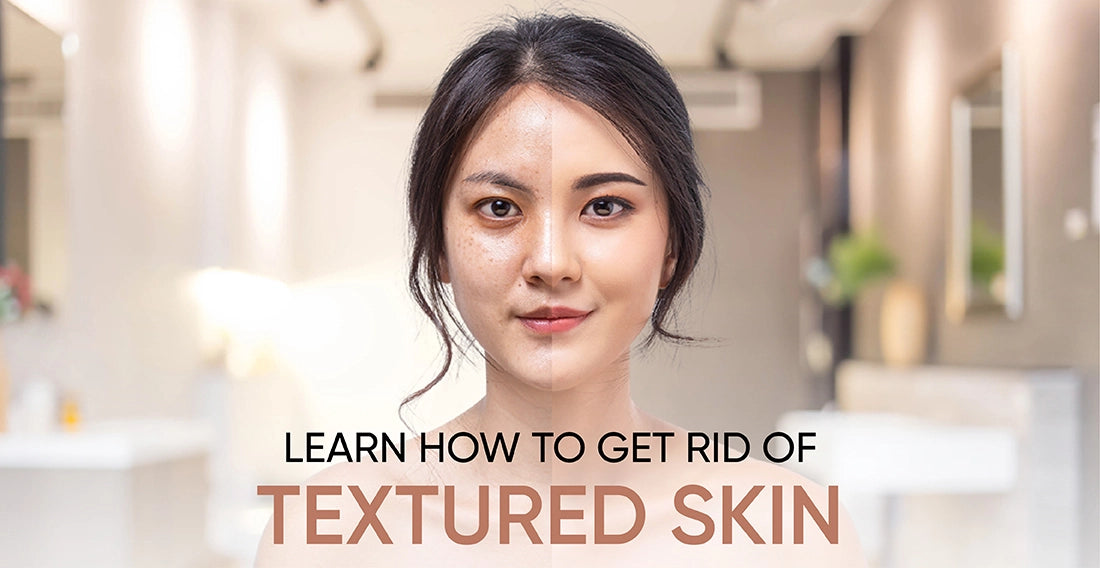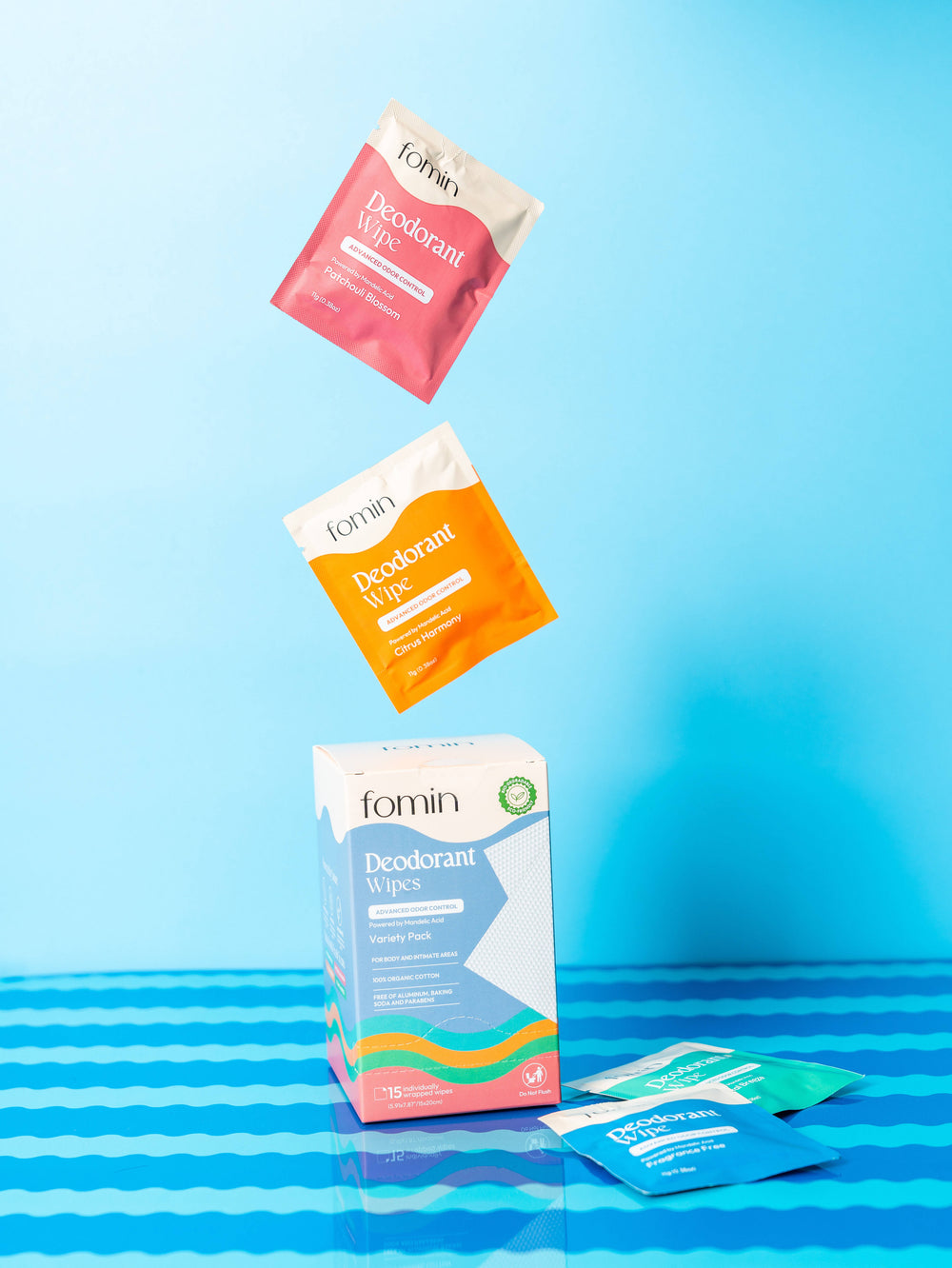
Learn How to Get Rid of Textured Skin | Step-by-Step Guide
Share
Have you ever wished for skin as smooth as a magazine cover? It's tempting to believe that flawless skin is the norm, especially when makeup and filters create that illusion. But the truth is, real skin has texture – bumps, pores, and all. And while that's absolutely normal, certain things like acne scars or skin issues can make you feel less confident. It's okay to want to reduce that texture. That's where we can help.
We've talked to skin experts to gather easy tips and tricks for you. Plus, we'll explain why your skin might have texture in the first place. This guide is your pathway to learning simple steps to say goodbye to uneven skin and feel better about yourself.
What is Textured Skin?
Textured skin is a term used to describe an uneven or irregular surface on the skin. It refers to skin that doesn't feel perfectly smooth to the touch. Instead, it might have bumps, rough patches, acne scars, enlarged pores, or other imperfections that disrupt the overall smoothness of the skin's surface.
What Causes Textured Skin?

The path to smoother skin begins with understanding what causes those pesky textures in the first place. Various factors contribute to textured skin, and getting a grasp on them can help you tailor your approach for effective results.
Acne Scars
One of the most common culprits is acne. When pimples heal, they can leave behind scars and unevenness on the skin's surface. These scars disrupt the smooth texture, creating bumps or depressions.
Enlarged Pores
Pore size can also play a role in textured skin. When pores become clogged with oil, dead skin cells, and debris, they can appear larger and more noticeable, contributing to an uneven complexion.
Uneven Skin Tone
Discoloration and uneven skin tone can create the illusion of texture. Dark spots, redness, and areas of hyperpigmentation draw attention to irregularities on the skin.
Skin Conditions
Conditions like eczema, rosacea, psoriasis, and keratosis pilaris can lead to rough patches and bumps, further adding to the overall texture of the skin.
Genetic Factors
Sometimes, textured skin can be inherited. Your genes play a role in determining your skin's characteristics, including its texture.
Sun Exposure
UV rays from the sun can damage the skin over time, breaking down collagen and elastin fibers. This can lead to a loss of skin firmness and contribute to textural changes.
Aging
As we age, the natural processes of collagen and elastin depletion can lead to a loss of skin elasticity and smoothness, resulting in textural irregularities.
Dr. Emily Steven, a board-certified dermatologist, explains that environmental pollutants like air pollution and UV rays can damage the skin's barrier and contribute to uneven texture. Renowned skincare expert Dr. Sophia Turner also highlights the impact of sun exposure on skin texture.
Step-by-Step Guide to Get Rid of Textured Skin

Now that you understand the reasons behind textured skin, it's time to take proactive steps towards achieving a smoother complexion. A well-crafted skincare routine can work wonders in minimizing texture and revealing your skin's natural beauty. Here's a step-by-step guide on how to get rid of bumpy textured skin:
Step 1: Gentle Cleansing
The foundation of any skincare routine is cleansing. However, when dealing with textured skin, it's essential to choose a gentle cleanser that won't strip away the skin's natural moisture barrier. Opt for a cleanser that is free from harsh chemicals and fragrances, as these can exacerbate the issue.
Step 2: Exfoliation Is Key
Exfoliation is a crucial step in smoothing out textured skin. By removing the layer of dead skin cells that sits on the surface, you'll reveal the fresh, healthy skin underneath. Choose a chemical exfoliant containing ingredients like glycolic acid or salicylic acid. Start with a lower concentration to avoid irritation and gradually increase as your skin gets accustomed.
Step 3: Hydration and Moisturization
Proper hydration is essential for plumping up the skin and minimizing the appearance of texture. Incorporate a hydrating serum containing hyaluronic acid into your routine, followed by a moisturizer suitable for your skin type. Hydrated skin looks smoother and more supple.
Step 4: Targeted Treatments
Consider adding targeted treatments to your routine to address specific textured areas. Retinol, for example, can stimulate collagen production and promote skin renewal. Vitamin C serums can help fade dark spots and improve overall skin tone. Always introduce new treatments gradually and perform a patch test to avoid adverse reactions.
Step 5: Sun Protection
Don't underestimate the power of sun protection. It's a vital step you simply can't afford to skip. Sun damage not only worsens skin texture but also accelerates premature aging. Incorporate a daily application of broad-spectrum sunscreen to safeguard your skin from the harmful effects of UV rays. This proactive measure goes a long way in preserving your skin's smoothness and overall health.
Remember, consistency is key. Results won't happen overnight, but with patience and dedication to your routine, you'll gradually notice improvements in your skin's texture and overall appearance. Adjust your routine as needed based on your skin's response, and don't hesitate to seek professional advice if you're unsure about the best approach for your skin type and concerns.
Ready for Textured-Free, Radiant Skin? Try Fomin Today!

Tired of textured skin all over your body? At Fomin, we recognize that rough, uneven skin can stem from a range of factors affecting different body areas. That's precisely why we're here – to offer you a touch of indulgence and care. Our lineup of specially curated products, from cleansing wipes to soap sheets, is meticulously designed to elevate your skincare regimen. Immerse yourself in the captivating scents of lavender and rose as you cleanse and refresh.
Lifestyle Changes for Smoother Skin
Achieving smoother skin goes beyond skincare products alone. Your daily habits and lifestyle choices can significantly impact your skin's texture and overall health. Here are some lifestyle changes to consider:
Balanced Diet
What you eat reflects on your skin. A diet rich in antioxidants, vitamins, and minerals can promote skin health. Opt for fruits, vegetables, lean proteins, and whole grains. Hydration is also essential, so drink plenty of water.
Sleep Quality
Adequate sleep allows your skin to repair and rejuvenate. Aim for 7-9 hours of quality sleep each night to support your skin's natural healing processes.
Stress Management
Chronic stress can worsen skin conditions and contribute to texture. Practice stress-reduction techniques like meditation, yoga, or deep breathing to keep stress levels in check.
Avoid Smoking and Alcohol
Smoking and excessive alcohol consumption can deplete your skin of nutrients and oxygen, leading to premature aging and texture issues. Quit smoking and moderate alcohol intake for healthier skin.
Regular Exercise
Exercise boosts blood circulation, which nourishes the skin and promotes a healthy glow. Just remember to cleanse your skin after sweating to prevent clogged pores.
Proper Sleep Hygiene
Use clean pillowcases and sheets to minimize the transfer of dirt and oil to your skin. Consider sleeping on your back to prevent friction between your skin and the pillow.
Hands Off
Touching your face frequently can transfer dirt and bacteria, exacerbating texture and causing breakouts. Avoid picking at blemishes, as this can lead to scars and unevenness.
Incorporating these lifestyle adjustments alongside your skincare routine can amplify your efforts in achieving smoother skin. While it may take time to see the full effects, the combination of the right products and healthy habits will contribute to a more radiant and even complexion over time.
How to Get Rid of Textured Skin on Face?
Professional Treatments

When it comes to tackling textured skin on your face, professional treatments can offer more intensive and targeted solutions. These treatments are often performed by dermatologists or licensed skincare professionals. Here's a breakdown of some effective options on how to get rid of skin texture:
Chemical Peels
Chemical peels involve applying a solution to the skin that exfoliates the top layer, promoting cell turnover and revealing smoother skin underneath. Different strengths of peels are available, and they can help with acne scars, uneven tone, and texture.
Microdermabrasion
This non-invasive treatment uses a machine to exfoliate the outer layer of skin, buffing away dead cells and encouraging cell renewal. Microdermabrasion can improve the appearance of fine lines, acne scars, and overall texture.
Laser Resurfacing
Laser treatments target specific skin concerns by emitting concentrated light energy. Fractional laser resurfacing, for example, stimulates collagen production, reducing the appearance of scars and improving texture.
Microneedling
Microneedling involves using tiny needles to create micro-injuries in the skin. This prompts the skin's natural healing process, leading to increased collagen production and smoother texture over time.
Radiofrequency Therapy
Radiofrequency devices use energy to heat the skin's deeper layers, stimulating collagen production and tightening the skin. This can improve skin laxity, texture, and overall appearance.
Dermal Fillers
Injectable dermal fillers can plump up depressed scars and areas of unevenness, creating a smoother surface. They provide temporary results and may need maintenance treatments.
FAQs
How to Get Rid of Textured Skin Overnight?
While you can't completely transform your skin overnight, you can take steps to improve texture before bed:
- Cleanse: Wash your face to remove dirt and oil.
- Exfoliate: Use a mild exfoliator to remove dead skin cells.
- Hydrate: Apply a hydrating mask or serum to plump the skin.
- Spot Treatment: Address specific texture issues with a targeted treatment.
- Moisturize: Seal in hydration with a lightweight moisturizer.
- Sleep Environment: Opt for a silk pillowcase and slightly elevate your head to reduce puffiness.
Consistent care, rather than quick fixes, will bring longer-lasting improvements to your skin's texture.
How to Get Rid of Textured Skin?
To get rid of textured skin, start with a gentle cleansing routine and regular exfoliation to remove dead skin cells. Hydrate your skin with a nourishing serum and moisturizer, and consider targeted treatments like retinol or vitamin C.


